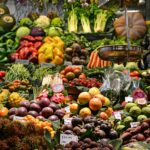Nutritional Content Differences between Fresh and Dried Fruits
To effectively compare fresh and dried fruits, we need to consider their nutritional values – from their vitamin and mineral content to the fiber they offer. Unsurprisingly, both variations are packed with essential nutrients which make them a crucial part of a balanced diet. According to this study, dietary fiber present in fruit plays a key role in preventing a variety of diseases.
Fresh fruits, are powerhouses of vitamin C and other water-soluble vitamins. Being organic and untreated, they also retain their water content which aids digestion. On the other hand, dried fruits, which are dehydrated, concentrate more calories and nutrients per gram compared to their fresh counterparts. This includes significant amounts of dietary fiber, enhancing gut health and longevity.
The Impact of Drying Process on Nutritional Value
The drying process has a significant impact on nutritional values, altering some nutrients while preserving others. During drying, water-soluble vitamins like vitamin C and B-complex may degrade. However, the minerals, fiber and antioxidants remain largely unaffected proving that dried fruits are not only convenient but also nutritious.
However, not all dried fruits are created equal. Some are treated with sulfites to lengthen shelf life and enhance color, which can cause allergic reactions in certain people. Therefore, you might want to consider buying dried fruits that are free from added sugars and artificial preservatives.
Benefits and Downsides of Consuming Dried Fruits
Dried fruits have a special place in a healthy diet. Their high fiber content helps regulate digestion and can aid in weight control by promoting satiety. They also offer an energy-dense snack for those engaging in physical activities.
However, there are potential downsides too. Despite their nutritional value, dried fruits are higher in sugar content and calories than fresh ones. This is especially true for varieties that have additional sugar added during the drying process, making portion control essential.
Benefits and Downsides of Consuming Fresh Fruits
Fresh fruits are a dietary staple, loved for their abundance of nutrients and their hydrating properties. They are rich in water-soluble vitamins, and low in calories which can be beneficial for weight management.
However, accessibility can pose a challenge. Fresh fruits require refrigeration and have a shorter shelf life than dried ones. Moreover, seasonal availability may limit the variety of fresh fruits on offer at any given time of the year.
Environmental Impact of Fresh vs. Dried Fruits
The environmental impact of fresh and dried fruits is a complex issue. Growing fruits demands water, and some fruits causing a heavier water footprint compared to others. The process of drying fruit, however, consumes energy and can generate waste.
Regarding transportation and waste generation, dried fruits may offer an advantage. They are lightweight and non-perishable, reducing both transportation emissions and food waste. To truly assess the impact, it’s crucial to consider the entire life cycle of the product, including where and how the fruit was grown, processed, and transported.




